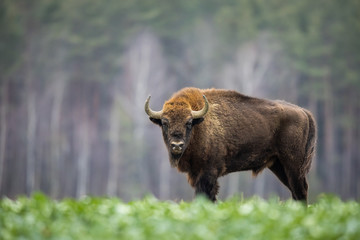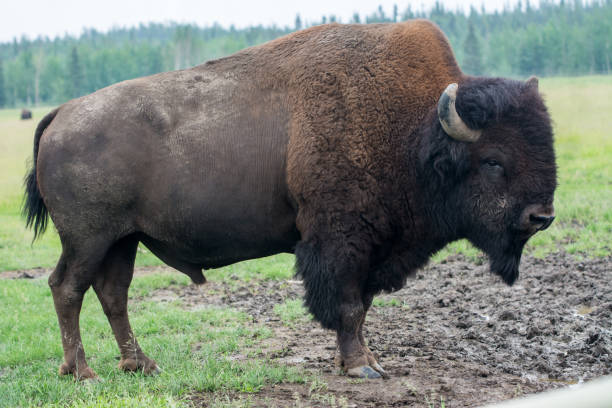Table of Contents
Scientific Classification
| Kingdom | Animalia |
| Phylum | Chordata |
| Class | Mammalia |
| Order | Artiodactyla |
| Family | Bovidae |
| Genus | Bison |
| Species | Bison Bison |
| Scientific Name | Bison bison athabascae |
1. Description
The wood bison (Bison bison) are impressive animals. They can reach heights of 6.5 feet (2 meters) at the shoulder. Their weight ranges from 1,800 to 2,600 pounds (800-1,200 kg). Males are much larger than females. They have a dark brown, shaggy coat. A pronounced hump sits on their shoulders. This hump holds strong muscles that help them clear snow while foraging in winter. Wood bison are taller than plains bison. They have a more square-shaped hump. Also, they have less fur on their front legs and head.
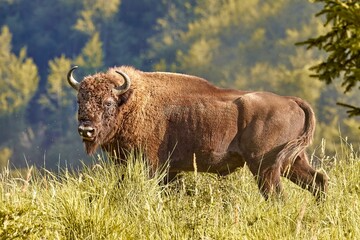
2. Distribution
Wood bison once roamed extensively across Canada and Alaska, but their habitat has significantly diminished due to habitat loss and overhunting. Currently, they are primarily found in Canada, particularly in the boreal forests of Alberta, British Columbia, the Northwest Territories, and Yukon. Conservation initiatives have also successfully reintroduced some populations back into Alaska, with the goal of restoring their historical range and ensuring their survival.
3. Habitat
Wood bison primarily inhabit boreal forests and wetlands, distinguishing them from plains bison that prefer open grasslands. They flourish in meadows, river valleys, and regions abundant in sedges, willows, and grasses. These environments offer ample food sources and protection from severe winters and predators. Their habitat consists of large open spaces interspersed with forests, which allows them to access shelter and food throughout the year.
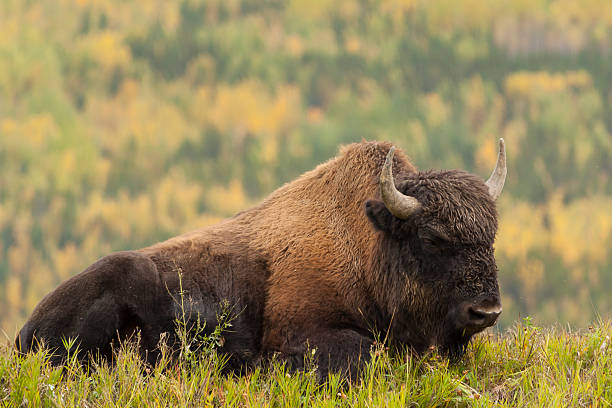
4. Diet
Wood bison are herbivores that primarily consume grasses, sedges, mosses, and various other plants found in their environment. During winter, they utilize their strong neck muscles and heads to clear away deep snow, allowing them to access food that is buried beneath. Unlike some larger herbivores, they do not rely on woody plants; instead, they favor nutrient-rich, herbaceous vegetation. Their digestive systems are well-adapted to efficiently extract nutrients from tough plant materials, enabling them to endure the harsh conditions of northern winters, even when food is scarce.
5. Behavior
Wood bison are social animals. They live in herds for protection against predators. Herds usually follow a matriarchal structure. Older females lead groups of cows and calves. Bulls often form bachelor groups when it’s not breeding season. But during the rut, they return to the main herd. Bison use grunts, snorts, and body language to communicate. They share warnings, show mating readiness, and express social hierarchy. They are huge, but they’re also very quick. When threatened, they can reach speeds of up to 40 mph (65 km/h).
6. Lifespan
In the wild, wood bison have an average lifespan of 15 to 20 years, although some individuals can live up to 25 years. In captivity, with fewer predators and steady food supply, they might live longer. Their survival rate largely depends on environmental conditions, human activity, and predation pressure.
7. Reproduction and Lifecycle
Wood bison have a breeding season, or rut, that occurs from July to September. During this time, dominant males fight for mating rights. They do this by head-butting and showing their strength. After a gestation period of approximately 270 to 285 days, a single calf is born in late spring or early summer. Calves are reddish-brown when they are born. They rely heavily on their mothers for food and safety. They start grazing on plants in a few weeks, but they keep nursing for several months. Female bison become mature for reproduction at about three years old. Males, however, take longer. They usually start breeding well at five or six years old. That’s when they can compete with older bulls.
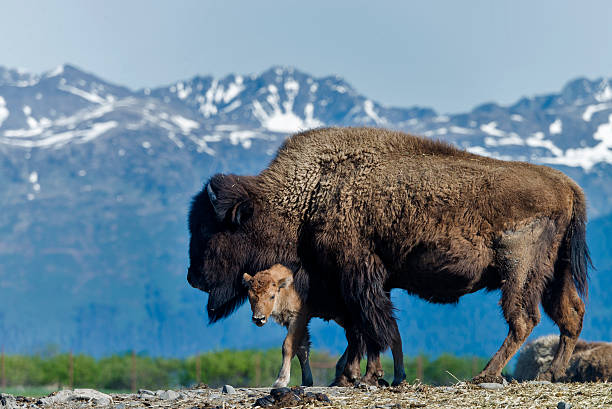
8. Predators
Wood bison have few natural predators. Their large size and herding behaviour help keep them safe. However, wolves are their main threat. Wolf packs focus on young, sick, or isolated bison. They use teamwork to hunt and take down these large animals. Occasionally, grizzly bears may attack young calves, but such incidents are rare. In the past, human hunting was the biggest threat to wood bison. It nearly drove them to extinction in the late 19th and early 20th centuries.
9. Adaptations
- Large Shoulder Hump: The noticeable hump is made of strong muscles. These muscles help them move snow in winter to reach food.
- Thick Fur Coat: Their dense, woolly fur provides insulation against extreme cold temperatures.
- Efficient Digestion: Their digestive system helps them get nutrients from tough, low-quality plants.
- Keen Senses: They hear well and smell better. This helps them spot predators and find food from far away.
- Strong Legs: Even with their size, they can run fast and swim across rivers when needed.
10. Conservation Status
Wood bison are now “Near Threatened” on the IUCN Red List. Their numbers are slowly improving thanks to conservation efforts. At one point, their numbers fell to only a few hundred because of overhunting and habitat loss. Conservation programs in Canada and Alaska have helped animals flourish in the wild once more. This effort has helped to stabilise their numbers.
Threats to their survival include:
- Habitat Loss: Expanding human development and deforestation reduce their natural habitat.
- Disease: Bovine tuberculosis and brucellosis have affected some herds, threatening their long-term survival.
Conservation groups target three main areas: habitat protection, disease management, and controlled breeding. These efforts aim to secure the species’ future. Indigenous communities have been vital in these efforts. They advocate for restoring bison populations and highlight their cultural importance.
Conclusion
The wood bison is a symbol of resilience, power, and the natural beauty of North America. As one of the biggest land animals in the Western Hemisphere, it helps keep ecological balance. Despite past challenges, current conservation efforts give hope for its future survival. Protecting these incredible animals lets future generations see them in the wild. This helps people appreciate their role in North American ecosystems.
